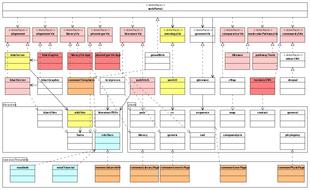Difference between revisions of "GMOD Components"
m |
m |
||
| Line 6: | Line 6: | ||
[[Image:roadmap25.jpg]] | [[Image:roadmap25.jpg]] | ||
| − | + | ||
| + | '''Symbols used in this UML diagram''' | ||
| + | * boxes | ||
| + | ** tabbed white boxes are packages -- logical groups of related components | ||
| + | ** boxes marked with ''<<interface>>'' are abstract interfaces required by GMOD-Web. All other labeled boxes are concrete components of the GMOD system. | ||
| + | * connectors | ||
| + | ** solid arrows indicate a relationship between components that currently exists. | ||
| + | ** dashed arrows indicate a relationship between components that does NOT currently exist. | ||
| + | ** dashed arrows with a solid white head indicate an interface/realization relationship between a GMOD-Web required interface and a component that provides that interface. e.g. gbrowse implements the "genomeVis" interface. | ||
| + | * coloration | ||
| + | ** white: components or interfaces that currently exist and integrated into the GMOD system. | ||
| + | ** green: components or interfaces that currently exist and are integrated into the GMOD system. | ||
| + | ** pink: components or interfaces that currently exist, but the feasibility of integrating their functionality into the GMOD system is unknown. | ||
| + | ** red: components that do not currently exist, but may need to be implemented. | ||
| + | ** orange: a common set of templates to provide a consistent look and feel for all GMOD systems. The "common gene page" concept is in this group. | ||
| + | ** cyan: components that are specific to each MOD, and are not deployable as part of a GMOD system. | ||
GMOD components fulfilling the requirements of an interface are linked to the interface, as well as to the Chado schema modules if they are known to interact with Chado. The requirements of an interface, as well as the components that implement a given interface are described in the documents linked at the end of this document. | GMOD components fulfilling the requirements of an interface are linked to the interface, as well as to the Chado schema modules if they are known to interact with Chado. The requirements of an interface, as well as the components that implement a given interface are described in the documents linked at the end of this document. | ||
| − | |||
| − | |||
| − | |||
| Line 29: | Line 41: | ||
* [[Workflow Management]] | * [[Workflow Management]] | ||
| − | |||
| − | |||
| − | |||
| − | |||
| − | |||
| − | |||
| − | |||
| − | |||
| − | |||
| − | |||
| − | |||
| − | |||
| − | |||
| − | |||
| − | |||
| − | |||
| − | |||
| − | |||
| − | |||
| − | |||
| − | |||
| − | |||
| − | |||
[[Category:To Do]] | [[Category:To Do]] | ||
Revision as of 02:58, 14 February 2007
GMOD is a loose federation of software applications (components) aimed at providing functionality that is needed by all model organism databases.
This diagram represents a model organism database (MOD) and its typical components. The "top ten" types of functionality are represented in the top row of the diagram as a set of interfaces. The "Vis" prefix on the end of each interface is an abbreviation of "Visualization", and should be interpreted literally -- an alignment visualization interface should not merely allow users to passively view pre-existing alignments, but should also to user interaction to create and visualize alignments of their own.
Symbols used in this UML diagram
- boxes
- tabbed white boxes are packages -- logical groups of related components
- boxes marked with <<interface>> are abstract interfaces required by GMOD-Web. All other labeled boxes are concrete components of the GMOD system.
- connectors
- solid arrows indicate a relationship between components that currently exists.
- dashed arrows indicate a relationship between components that does NOT currently exist.
- dashed arrows with a solid white head indicate an interface/realization relationship between a GMOD-Web required interface and a component that provides that interface. e.g. gbrowse implements the "genomeVis" interface.
- coloration
- white: components or interfaces that currently exist and integrated into the GMOD system.
- green: components or interfaces that currently exist and are integrated into the GMOD system.
- pink: components or interfaces that currently exist, but the feasibility of integrating their functionality into the GMOD system is unknown.
- red: components that do not currently exist, but may need to be implemented.
- orange: a common set of templates to provide a consistent look and feel for all GMOD systems. The "common gene page" concept is in this group.
- cyan: components that are specific to each MOD, and are not deployable as part of a GMOD system.
GMOD components fulfilling the requirements of an interface are linked to the interface, as well as to the Chado schema modules if they are known to interact with Chado. The requirements of an interface, as well as the components that implement a given interface are described in the documents linked at the end of this document.
- Community Visualization
- Comparative Genomics Visualization
- Database tools
- Gene Expression Visualization
- Genome Visualization & Editing
- GMODWeb
- Literature Visualization
- Molecular Pathway Visualization
- Ontology Visualization
- Phenotype Visualization
- Sequence Alignment
- Strain/Library Visualization
- Utilities
- Workflow Management
